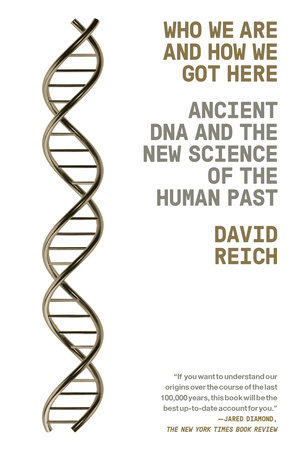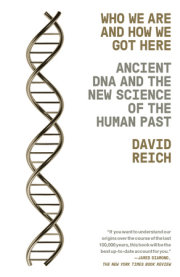Part IThe Deep History of Our Species1How the Genome Explains Who We AreThe Master Chronicle of Human VariationTo understand why genetics is able to shed light on the human past, it is necessary to understand how the genome—defined as the full set of genetic code each of us inherits from our parents—records information. James Watson, Francis Crick, Rosalind Franklin, and Maurice Wilkins showed in 1953 that the genome is written out in twin chains of about three billion chemical building blocks (six billion in all) that can be thought of as the letters of an alphabet: A (adenine), C (cytosine), G (guanine), and T (thymine).1 What we call a “gene” consists of tiny fragments of these chains, typically around one thousand letters long, which are used as templates to assemble the proteins that do most of the work in cells. In between the genes is noncoding DNA, sometimes referred to as “junk” DNA. The order of the letters can be read by machines that perform chemical reactions on fragments of DNA, releasing flashes of light as the reactions pass along the length of the DNA sequence. The reactions emit a different color for each of the letters A, C, G, and T, so that the sequence of letters can be scanned into a computer by a camera.
Although the great majority of scientists are focused on the biological information that is contained within the genes, there are also occasional differences between DNA sequences. These differences are due to random errors in copying of genomes (known as mutations) that occurred at some point in the past. It is these differences, occurring about one every thousand letters or so in both genes and in “junk,” that geneticists study to learn about the past. Over the approximately three billion letters, there are typically around three million differences between unrelated genomes. The higher the density of differences separating two genomes on any segment, the longer it has been since the segments shared a common ancestor as the mutations accumulate at a more or less constant rate over time. So the density of differences provides a biological stopwatch, a record of how long it has been since key events occurred in the past.
The first startling application of genetics to the study of the past involved mitochondrial DNA. This is a tiny portion of the genome—only approximately 1/200,000th of it—which is passed down along the maternal line from mother to daughter to granddaughter. In 1987, Allan Wilson and his colleagues sequenced a few hundred letters of mitochondrial DNA from diverse people around the world. By comparing the mutations that were different among these sequences, he and his colleagues were able to reconstruct a family tree of maternal relationships. What they found is that the deepest branch of the tree—the branch that left the main trunk earliest—is found today only in people of sub-Saharan African ancestry, suggesting that the ancestors of modern humans lived in Africa. In contrast, all non-Africans today descend from a later branch of the tree.2 This finding became an important part of the triumphant synthesis of archaeological and genetic and skeletal evidence that emerged in the 1980s and 1990s for the theory that modern humans descend from ancestors who lived in the last hundred thousand years or so in Africa. Based on the rate at which mutations are known to accumulate, Wilson and his colleagues estimated that the most recent African ancestor of all the branches, “Mitochondrial Eve,” lived sometime after 200,000 years ago.3 The best current estimate is around 160,000 years ago, although it is important to realize that like most genetic dates, this one is imprecise because of uncertainty about the true rate at which human mutations occur.4
The finding of such a recent common ancestor was exciting because it refuted the “multiregional hypothesis,” according to which present-day humans living in many parts of Africa and Eurasia descend substantially from an early dispersal (at least 1.8 million years ago) of Homo erectus, a species that made crude stone tools and had brains about two-thirds the size of ours. The multiregional hypothesis implied that descendants of Homo erectus evolved in parallel across Africa and Eurasia to give rise to the populations who live in the same places today. The multiregional hypothesis would therefore predict that there would be mitochondrial DNA sequences among present-day people that are separated by more than a million years, the age of the dispersal of Homo erectus and its descendants. However, the genetic data was impossible to reconcile with this prediction. The fact that all people today share a common mitochondrial DNA ancestor about ten times more recently showed that humans today largely descend from a much later expansion from Africa.
Anthropological evidence pointed to a likely scenario for what occurred. The earliest human skeletons with “anatomically modern” features—defined as falling within the range of variation of all humans today with regard to having a globular brain case and other traits—date up to around three hundred thousand years ago and are all from Africa.5 Outside of Africa and the Near East, though, there is no convincing evidence of anatomically modern humans older than a hundred thousand years ago and very limited evidence more than fifty thousand years ago.6 Archaeological evidence of stone tool types also points to a great change after fifty thousand years ago, a period known to archaeologists of West Eurasia as the Upper Paleolithic, and to archaeologists of Africa as the Later Stone Age. After this time, the manufacture of stone tools became far more efficient, and there were changes in style every few thousand years, compared to the glacial earlier pace of change. Humans in this period also began to leave behind far more artifacts that revealed their aesthetic and spiritual lives: beads made of ostrich eggshells, polished stone bracelets, body paint made from red iron oxide, and the world’s first representational art. The world’s earliest known figurine is a roughly forty-thousand-year-old “lion-man” carved from a woolly mammoth tusk, found in Hohlenstein-Stadel in Germany.7 The approximately thirty-thousand-year-old drawings of pre–ice age beasts, found on the walls of Chauvet Cave in France, even today are recognizable as transcendent art.
The dramatic acceleration of change in the archaeological record after around fifty thousand years ago was also reflected by evidence of population change. The Neanderthals, who had evolved in Europe by around four hundred thousand years ago and are considered “archaic” in the sense that their body shape did not fall within present-day variation, went extinct in their last holdout of western Europe between about forty-one thousand and thirty-nine thousand years ago, within a few thousand years of the arrival of modern humans.8 Population turnovers also occurred elsewhere in Eurasia, as well as in southern Africa, where there is evidence of abandonment of sites and the sudden appearance of Later Stone Age cultures.9
The natural explanation for all these changes was the spread of an anatomically modern human population whose ancestors included “Mitochondrial Eve,” who practiced a sophisticated new culture, and who largely replaced the people who lived in each place before.
The Siren Call of the Genetic SwitchThe finding that genetics could help to distinguish between competing hypotheses of human origins led in the 1980s and 1990s to exuberance about the power of the discipline to provide simple explanations. Some even wondered if genetics might be able to do more than provide a supporting line of evidence for the spread of modern humans from Africa and the Near East after around fifty thousand years ago. Perhaps genes could also be the cause of that spread, offering an explanation as simple and beautiful as the four-letter code written in DNA for the quickening pace of change in the archaeological record.
The anthropologist best known for embracing the idea that a genetic change might explain how we came to be behaviorally distinct from our predecessors was Richard Klein. He put forward the idea that the Later Stone Age revolution of Africa and the Upper Paleolithic revolution of western Eurasia, when recognizably modern human behavior burst into full flower after about fifty thousand years ago, were driven by the rise in frequency of a single mutation of a gene affecting the biology of the brain, which permitted the manufacture of innovative tools and the development of complex behavior.
According to Klein’s theory, the rise in frequency of this mutation primed humans for some enabling trait, such as the ability to use conceptual language. Klein thought that prior to the occurrence of this mutation, humans were incapable of modern behaviors. Supporting his notion are examples among other species of a small number of genetic changes that have effected major adaptations, such as the five changes that are sufficient to turn the tiny ears of the Mexican wild grass teosinte into the huge cobs of corn that we buy in the supermarket today.10
Klein’s hypothesis came under intense criticism almost as soon as he suggested it, most notably from the archaeologists Sally McBrearty and Alison Brooks, who showed that almost every trait that Klein considered to be a hallmark of distinctly modern human behavior was evident in the African and Near Eastern archaeological records tens of thousands of years before the Upper Paleolithic and Later Stone Age transitions.11 But even if no single behavior was new, Klein had put his finger on something important. The intensification of evidence for modern human behavior after fifty thousand years ago is undeniable, and raises the question of whether biological change contributed to it.
One geneticist who came of age at this time of exuberance about the power of genetics to provide simple explanations for great mysteries was Svante Pääbo, who arrived in Allan Wilson’s laboratory just after the “Mitochondrial Eve” discovery, and who would go on to invent much of the toolkit of the ancient DNA revolution and to sequence the Neanderthal genome. In 2002, Pääbo and his colleagues discovered two mutations in the gene FOXP2 that seemed to be candidates for propelling the great changes that occurred after around fifty thousand years ago. The previous year, medical geneticists had identified FOXP2 as a gene that, when mutated, produces an extraordinary syndrome whose sufferers have normal-range cognitive capabilities, but cannot use complex language, including most grammar.12 Pääbo and his colleagues showed that the protein produced by the FOXP2 gene has remained almost identical during the more than hundred million years of evolution separating chimpanzees and mice. However, two changes to the protein occurred on just the human lineage since it branched out of the common ancestral population of humans and chimpanzees, suggesting that the gene had evolved much more rapidly on the human lineage.13 Later work by Pääbo and his colleagues found that engineered mice with the human versions of FOXP2 are identical to regular mice in most respects, but squeak differently, consistent with the idea that these changes affect the formation of sounds.14 These two mutations at FOXP2 cannot have contributed to the changes after fifty thousand years ago, since Neanderthals shared them,15 but Pääbo and his colleagues later identified a third mutation that is found in almost all present-day humans and that affects when and in what cells FOXP2 gets turned into protein. This change is absent in Neanderthals, and thus is a candidate for contributing to the evolution of modern humans after their separation from Neanderthals hundreds of thousands of years ago.16
Regardless of how important FOXP2 itself is in modern human biology, Pääbo cites the search for the genetic basis for modern human behavior as a justification for sequencing the genomes of archaic humans.17 Between 2010 and 2013, when he led a series of studies that published whole-genome sequences from archaic humans like Neanderthals, Pääbo’s papers highlighted an evolving list of about one hundred thousand places in the genome where nearly all present-day humans carry genetic changes that are absent in Neanderthals.18 There are surely biologically important changes hiding in the list, but we are still only at the very beginning of the process of determining what they are, reflecting a more general problem that we are like kindergartners in our ability to read the genome. While we have learned to decode the individual words—as we know how the sequence of DNA letters gets turned into proteins—we still can’t parse the sentences.
The sad truth is that it is possible to count on the fingers of two hands the examples like FOXP2 of mutations that increased in frequency in modern humans under the pressure of natural selection and whose functions we partly understand. In each of these cases, the insights only came from years of hand-to-hand combat with life’s secrets by graduate students or postdoctoral scientists making engineered mice or fish, suggesting that it will take an evolutionary Manhattan Project to understand the function of each mutation that we have and that Neanderthals do not. This Manhattan Project of human evolutionary biology is one to which we as a species should commit ourselves. But even when it is carried out, I expect that the findings will be so complicated—with so many individual genetic changes contributing to what makes humans distinctive—that few people will find the answer comprehensible. While the scientific question is profoundly important, I expect that no intellectually elegant and emotionally satisfying molecular explanation for behavioral modernity will ever be found.
But even if studying just a few locations in the genome will not provide a satisfying explanation for how modern human behavior evolved, the great surprise of the genome revolution is the explanations it is starting to provide from another perspective—that of history. By comprehending the entire genome—by going beyond the tiny slice of the past sampled by our mitochondrial DNA and Y chromosome and embracing the story of our past told by the multiplicity of our ancestors that is written in the record of our whole genome—we have already begun to sketch out a new picture of how we got to be the way we are. This explanation based on migrations and population mixture is the subject of this book.
Copyright © 2018 by David Reich. All rights reserved. No part of this excerpt may be reproduced or reprinted without permission in writing from the publisher.




